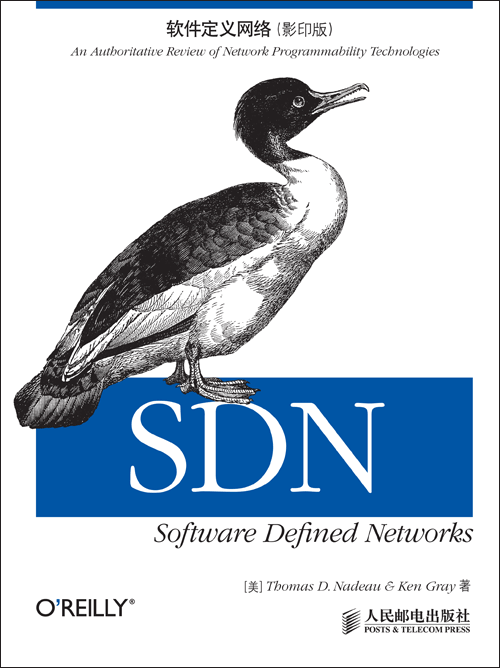软件定义网络(影印版)
出版时间:2013年11月
页数:352
软件定义网络(SDN)是由软件定义、驱动,并且可编程的网络。本书是SDN的全面、权威指南,详细讲解了SDN的新兴定义、协议和标准。两位资深的网络工程师在书中为读者讲解了构建软件定义网络(即使用软件在应用和底层网络设施之间进行双向通信)所必需的知识。
本书与具体厂商的产品无关,它讲解的是一些与带宽调度和操作、输入流量、触发行为等相关的SDN用例,另外还展示了一些与大数据、数据中心覆盖和网络功能虚拟化等相关的有趣用例。
· 探究OpenFlow模型和集中网络控制的当前进展;
· 剖析分布式控制和集中控制,包括数据平面生成;
· 详解商业控制器和开源控制器的结构和功能;
· 学习网络可编程性的现有技术;
· 探究以桌面为中心的模型到高度分布式模型在内的现代数据中心;
· 网络功能虚拟化和服务链的连接实例;
· 构建和维护SDN网络拓扑;
· 探究用于控制器、应用和生态系统的理想SDN框架。
“本书对SDN的当前进展、状态进行了详细客观的陈述,对于对SDN感兴趣的任何人来说,本书都是必备读物。”
——Michael Beesley,苏特希尔公司常驻工程师;Juniper公司平台与服务部门前CTO
“两位作者成功地展示了SDN的广袤前景,并将与SDN相关的知识成功串联起来,从而奠定了SDN的伟大蓝图。”
——David Ward,Cisco公司首席架构师
“业界对SDN是什么以及SDN为什么如此重要一直有很大困惑,本书以令人耳目一新的方式,对SDN进行了全面深入的剖析。阅读了本书之后,业界对SDN的困惑、炒作,从此尘埃落定。”
——Mike Bushong,Plexxi公司市场营销副总裁
本书与具体厂商的产品无关,它讲解的是一些与带宽调度和操作、输入流量、触发行为等相关的SDN用例,另外还展示了一些与大数据、数据中心覆盖和网络功能虚拟化等相关的有趣用例。
· 探究OpenFlow模型和集中网络控制的当前进展;
· 剖析分布式控制和集中控制,包括数据平面生成;
· 详解商业控制器和开源控制器的结构和功能;
· 学习网络可编程性的现有技术;
· 探究以桌面为中心的模型到高度分布式模型在内的现代数据中心;
· 网络功能虚拟化和服务链的连接实例;
· 构建和维护SDN网络拓扑;
· 探究用于控制器、应用和生态系统的理想SDN框架。
“本书对SDN的当前进展、状态进行了详细客观的陈述,对于对SDN感兴趣的任何人来说,本书都是必备读物。”
——Michael Beesley,苏特希尔公司常驻工程师;Juniper公司平台与服务部门前CTO
“两位作者成功地展示了SDN的广袤前景,并将与SDN相关的知识成功串联起来,从而奠定了SDN的伟大蓝图。”
——David Ward,Cisco公司首席架构师
“业界对SDN是什么以及SDN为什么如此重要一直有很大困惑,本书以令人耳目一新的方式,对SDN进行了全面深入的剖析。阅读了本书之后,业界对SDN的困惑、炒作,从此尘埃落定。”
——Mike Bushong,Plexxi公司市场营销副总裁
- foreword by david meyer
- foreword by david ward
- prefacex
- 1. introduction
- 2. centralized and distributed control and data planes
- introduction
- evolution versus revolution
- what do they do?
- the control plane
- data plane
- moving information between planes
- why can separation be important?
- distributed control planes
- ip and mpls
- creating the ip underlay
- convergence time
- load balancing
- high availability
- creating the mpls overlay
- .replication
- centralized control planes
- logical versus literal
- atm/lane
- route servers
- conclusions
- 3. openflow
- introduction
- wire protocol
- replication
- fawg (forwarding abstraction workgroup)
- config and extensibility
- architecture
- hybrid approaches
- ships in the night
- dual function switches
- conclusions
- 4. sdn controllers
- introduction
- general concepts
- vmware
- nicira
- vmware/nicira
- openflow-related
- mininet
- nox/pox
- trema
- ryu
- big switch networks/floodlight
- layer 3 centric
- l3vpn
- path computation element server
- plexxi
- plexxi affinity
- cisco onepk
- relationship to the idealized sdn framework
- conclusions
- 5. network programmability
- introduction
- the management interface
- the application-network divide
- the command-line interface
- netconf and netmod
- snmp
- modern programmatic interfaces
- publish and subscribe interfaces
- xmpp
- google’s protocol buffers
- thrift
- json
- i2rs
- modern orchestration
- openstack
- cloudstack
- puppet
- conclusions
- 6. data center concepts and constructs
- introduction
- the multitenant data center
- the virtualized multitenant data center
- orchestration
- connecting a tenant to the internet/vpn
- virtual machine migration and elasticity
- data center interconnect (dci)
- fallacies of data center distributed computing
- data center distributed computing pitfalls to consider
- sdn solutions for the data center network
- the network underlay
- vlans
- evpn
- locator id split (lisp)
- vxlan
- nvgre
- openflow
- network overlays
- network overlay types
- conclusions
- 7. network function virtualization
- introduction
- virtualization and data plane i/o
- data plane i/o
- i/o summary
- services engineered path
- service locations and chaining
- metadata
- an application level approach
- scale
- nfv at etsi
- non-etsi nfv work
- middlebox studies
- embrane/linerate
- platform virtualization
- conclusions
- 8. network topology and topological information abstraction
- introduction
- network topology
- traditional methods
- lldp
- bgp-te/ls
- bgp-ls with pce
- alto
- bgp-ls and pce interaction with alto
- i2rs topology
- conclusions
- 9. building an sdn framework
- introduction
- build code first; ask questions later...
- the juniper sdn framework
- ietf sdn framework(s)
- sdn(p)
- abno
- open daylight controller/framework
- api
- high availability and state storage
- analytics
- policy
- conclusions
- 10. use cases for bandwidth scheduling, manipulation, and lendaring
- introduction
- bandwidth calendaring
- base topology and fundamental concepts
- openflow and pce topologies
- example configuration
- openflow provisioned example
- enhancing the controller
- overlay example using pce provisioning
- expanding your reach: barbarians at the gate
- big data and application hyper-virtualization for instant cspf
- expanding topology
- conclusions
- 11. use cases for data center overlays, big data, and network function virtualization
- introduction
- data center orchestration
- creating tenant and virtual machine state
- forwarding state
- data-driven learning
- control-plane signaling
- scaling and performance considerations
- puppet (devops solution)
- network function virtualization (nfv)
- nfv in mobility
- optimized big data
- conclusions
- 12. use cases for input traffic monitoring, classification, and triggered actions
- introduction
- the firewall
- firewalls as a service
- network access control replacement
- extending the use case with a virtual firewall
- feedback and optimization
- intrusion detection/threat mitigation
- conclusions
- 13. final thoughts and conclusions
- what is true about sdn?
- economics
- sdn is really about operations and management
- multiple definitions of sdn
- are we making progress yet?
- index
书名:软件定义网络(影印版)
作者:Thomas D. Nadeau, Ken Gray 著
国内出版社:人民邮电出版社
出版时间:2013年11月
页数:352
书号:978-7-115-33574-6
原版书书名:SDN: Software Defined Networks
原版书出版商:O'Reilly Media
购买选项
